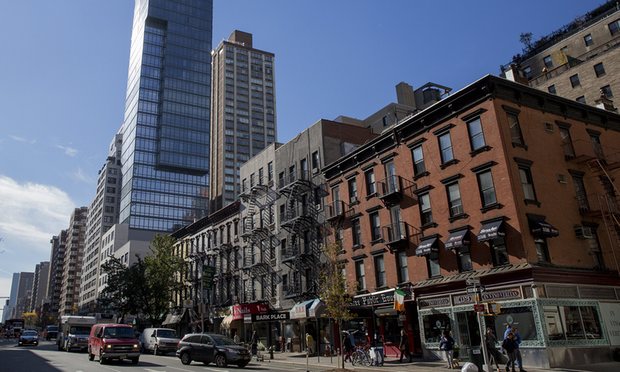The 1% Are Recovering from 2008 Recession While 99% Are Still Waiting
CAPITALISM, 11 Jul 2016
Jana Kasperkevic – The Guardian
In 2015, the income of the 99% grew by just 3.9% – ‘the best real income growth in 17 years’ – while the rich saw growth was twice that at 7.7%.

Luxury building ‘The Charles’ towers over First Avenue on the upper east side of Manhattan in New York. Photograph: Brendan Mcdermid/Reuters
6 Jul 2016 – The top 1% of Americans are finally recovering from the great recession. A new analysis of IRS data revealed that the average income of the top 1% of income earners grew by 7.7% in 2015, reaching $1.36m.
Report author Emmanuel Saez, an economics professor at the University of California-Berkeley, calculated earlier this year that the top 1% had an average income of $1.26m in 2014. And though the world’s wealthiest were able to raise that income to $1.36m within one year, they are still not making as much as they were just before the 2008 recession.
Saez revealed that in 2015, the rich were also taking home larger chunk of the US income. “The share of income going to the top 10% of income earners – those making on average about $300,000 a year – increased to 50.5% in 2015 from 50.0% in 2014, the highest ever except for 2012,” Saez wrote.
“The share of income going to the top 1% of families – those earning on average about $1.4m a year – increased to 22% in 2015 from 21.4% in 2014.”
According to him, while the 1% power ahead and continue to reclaim income lost during the recession, a full recovery for the bottom 99% remains elusive. “Six years after the end of the Great Recession, those families have recovered only about 60% of their income losses due to that severe economic downturn,” he said.
It should not come as a shock that to many Americans talk of economic recovery rings hollow. The top 1% of families saw their income grow by 37% between 2009 to 2015, from $990,000 to $1.36m. The incomes of the other 99%, however, grew by just 7.6% during that time – from $45,300 in 2009 to $48,800 in 2015.
In 2015, the income of the 99% grew by just 3.9%. After factoring in inflation, Saez calls it: “the best real income growth in 17 years”. And the rich? At 7.7%, their growth was twice that.
Economy remains a top concern for US voters, according to a recent Gallup survey of 1,530 adults. More than 90% of them said that economy was extremely important to them and 89% of them said the same of jobs and employment.
The income inequality has not escaped the attention of the Obama White House or those vying to succeed him.
“Inequality is still too high,” Barack Obama said in June while speaking about the US economy in Elkhart, Indiana. “The gap between rich and poor is bigger now than it’s been just about any time since the 1920s.”
For much of his two-term presidency, Obama has been pushing the US Congress to raise the federal minimum wage in hopes that it would raise incomes of the poorest Americans. Both former secretary of state Hillary Clinton and Vermont senator Bernie Sanders, who are running for president as Democrats, have pushed for higher minimum wage and spoken about income inequality on the campaign trail.
The uneven recovery is one of the reasons that experts say this presidential election cycle has seen the rise of Donald Trump and a contentious race for the Democratic nomination.
Go to Original – theguardian.com
DISCLAIMER: The statements, views and opinions expressed in pieces republished here are solely those of the authors and do not necessarily represent those of TMS. In accordance with title 17 U.S.C. section 107, this material is distributed without profit to those who have expressed a prior interest in receiving the included information for research and educational purposes. TMS has no affiliation whatsoever with the originator of this article nor is TMS endorsed or sponsored by the originator. “GO TO ORIGINAL” links are provided as a convenience to our readers and allow for verification of authenticity. However, as originating pages are often updated by their originating host sites, the versions posted may not match the versions our readers view when clicking the “GO TO ORIGINAL” links. This site contains copyrighted material the use of which has not always been specifically authorized by the copyright owner. We are making such material available in our efforts to advance understanding of environmental, political, human rights, economic, democracy, scientific, and social justice issues, etc. We believe this constitutes a ‘fair use’ of any such copyrighted material as provided for in section 107 of the US Copyright Law. In accordance with Title 17 U.S.C. Section 107, the material on this site is distributed without profit to those who have expressed a prior interest in receiving the included information for research and educational purposes. For more information go to: http://www.law.cornell.edu/uscode/17/107.shtml. If you wish to use copyrighted material from this site for purposes of your own that go beyond ‘fair use’, you must obtain permission from the copyright owner.